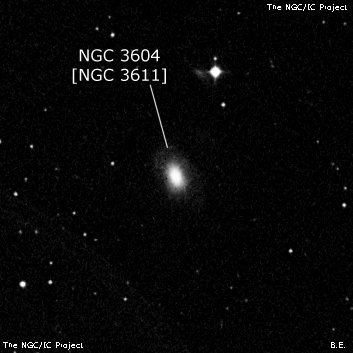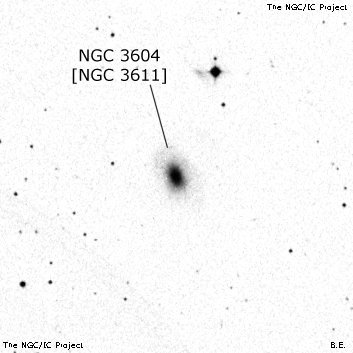NGC/IC Project Restoration Effort
(This is a very very beta version)
NGC3604


Basic Information
Location and Magnitude
Right Ascension: 11:17:30.1
Declination: +4:33:19
Constellation: LEO
Visual Magnitude: 12.2
Historic Information
Discoverer: Herschel W.
Year of discovery: 1786
Discovery aperture: 18.7
Observational
Summary description: pB, S, lE, mbM
Sub-type: Sa
Corwin's Notes
=====
NGC 3604 = NGC 3611. WH's RA is one minute too small, but his description is
apt for NGC 3611. Dreyer, without benefit of wide-field plates, comments in
his notes to WH's catalogue, "Should probably be rejected, together with III
88 (sic) and III 598 (NGC 3509), the only other neb this night, as there was
fog `which indeed was so strong as to make everything swim about me.' " NGC
3509 is also a minute of time east of WH's RA, reinforcing Reinmuth's
suggestion of the identity of N3604 with N3611.
I'm not sure, however, which object Dreyer means by "III 88." III 88 is
NGC 3401 (which see), and was found two and a half years earlier than the
other two objects. In WH's catalogues, only NGC 3509 is noted as being found
on the same night (30 Dec 1786) as N3604. Did Dreyer mean to have only III
598 in his comment? Probably so, but we can't be sure without seeing his MS.
Coincidentally, this object is also the first of 36 numbered and lettered
nebulae and stars that David Todd found during his 1877-1878 "Telescopic
search for the trans-Neptunian planet" with the USNO 26-inch refractor. He
has given us a nearly complete transcription of his observing notes in his AN
2698 article; this makes digging out the nebulae, and all the comments about a
single object, rather more difficult than is ideal. Also, Todd's positions
are very crude (apparently read from the refractor's setting circles), though
he has given us sketches of each object's field so that we can still
positively identify all but one of his objects (Dreyer, I'm sure, would have
done this had he had a sky survey at hand). Todd found at least two other
objects which were bright enough that he (correctly) assumed them to be known
nebulae.
Several people, including Wolfgang Steinicke, Steve Gottlieb, Klaus Wenzel
(inspired by one of Wolfgang's articles), Courtney Seligman, and me, have
tackled the list. Here are the identifications of each of his sketched
objects.
Todd's Modern name Type Note
number
(1) NGC 3604 = NGC 3611 Galaxy
(2) GSC 0838-0889 Star
(3) GSC 0848-1219 Star
(4) NGC 3427 Galaxy
(5) NGC 3462 Galaxy
(6) NGC 3436 Galaxy
(7) --- --- See comments below.
(8) IC 669 Galaxy
(9) NGC 3685 Galaxy
(10) NGC 3849 = IC 730 Galaxy
(11) NGC 4075 Galaxy
(12a) NGC 4073 Galaxy
(12d) NGC 4063 Galaxy
(13a) NGC 4045A Galaxy = CGCG 013-045
(13b) NGC 4045 Galaxy
(13e) CGCG 013-049 Galaxy
(14a) NGC 4077 = NGC 4140 Galaxy Same as (16a)
(14b) NGC 4139 = IC 2989 Galaxy Same as (16b)
(15) NGC 4179 Galaxy
(16a) NGC 4077 = NGC 4140 Galaxy Same as (14a)
(16b) NGC 4139 = IC 2989 Galaxy Same as (14b)
(17) NGC 4355 = NGC 4418 Galaxy
(18) NGC 4202 Galaxy
(19) GSC 0836-0339 Star
(20a) UCAC 514-051250 Star
(20b) NGC 3153 Galaxy
(20c) HIP 50085 Star This is not CGCG 064-091.
(21a) NGC 3134 Galaxy
(21b) UCAC 512-048943 Star
(22) IC 591 Galaxy
(23) CGCG 064-093 Galaxy = MCG +02-26-033
(24) NGC 3332 = NGC 3342 Galaxy
(25) CGCG 066-007 Galaxy = UGC 5864
(26) CGCG 065-074 Galaxy = MCG +02-27-033
(27) GSC 0841-1088 Star
(28) CGCG 065-073 Galaxy
(29) NGC 3217 = IC 606 Galaxy
(30) NGC 3279 = IC 622 Galaxy
Note that Courtney Seligman has found that Todd 20c is a star, and not -- as
I had previously supposed -- CGCG 064-091 (see the note under this number in
the "notngc" files).
I've checked that each of the sketches matches the sky as it appears on the
POSS1 prints or on the DSS. The stars were initially identified by Klaus
Wenzel; I have confirmed his identifications with one exception.
That exception is number (7). Klaus suggests that number (7) is also a star,
GSC 0268-0113, but the field around it does not match Todd's sketch with the
26-inch telescope. In addition, this star is just 2 arcmin south of IC 670
which is bright enough that Todd would have recorded it had he seen it. I
cannot find any star field that matches Todd's detailed sketch for number (7),
though his second sketch of the finder field (from 12 December 1877) pretty
closely matches the sky.
Unfortunately, his detailed field as sketched through the 26-inch is not at
the center of this finder field. His first finder field sketch from 3
December 1877 accompanying the 26-inch sketch is also unmatchable -- at least
by me -- with the sky.
Todd gives two different crude positions (11h00m, +07d10' on 3 Dec; and
11h00m, +07d17' on 12 Dec, both presumeably for the equinox of the date) for
that field center. These led me to the second finder field, but not the
first. He has several measurements of the stars in the field; you can see
these in his paper which is available at ADS (AN 113, 153, 1886). If you can
recover this object, or think that you can convince me that it is indeed
Klaus's star, please let me know. Thanks!
The remainder of the non-NGC objects are discussed in the "notngc" files.
Steve's Notes
=====
NGC 3604
See observing notes for NGC 3611.



